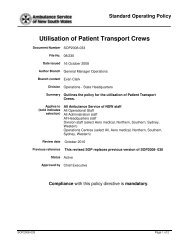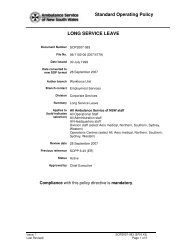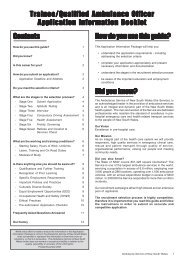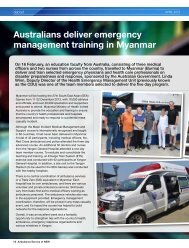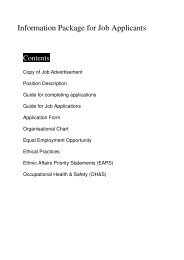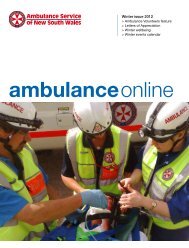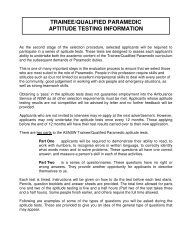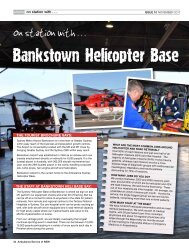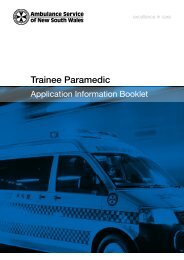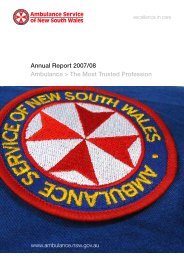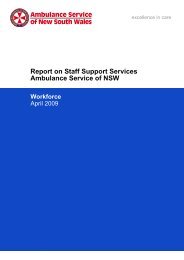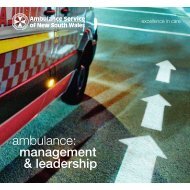atsb final report released 16 may 2013 - Ambulance Service of NSW
atsb final report released 16 may 2013 - Ambulance Service of NSW
atsb final report released 16 may 2013 - Ambulance Service of NSW
You also want an ePaper? Increase the reach of your titles
YUMPU automatically turns print PDFs into web optimized ePapers that Google loves.
and lighting systems. The ACM’s training record indicated that the endorsementalso included 3 flights that encompassed confined area and land winchingoperations. This included stretcher winching by day and night and familiarisationon the use <strong>of</strong> the helicopter’s flight management system, and with assisting the pilotas required.The ACM’s appointment to the EMS role at the Bankstown base was his firstexperience <strong>of</strong> single-pilot operation as an air crewman. In support <strong>of</strong> this role, theoperator required its ACMs to undergo a course <strong>of</strong> training to enable them to assistpilots with operational aspects such as the management <strong>of</strong> checklist procedures andthe use <strong>of</strong> the Nightsun. The operator advised that the ACM completed that trainingas part <strong>of</strong> his AW139 endorsement and, as such, it was not recorded separately. TheACM <strong>report</strong>ed that his previous use <strong>of</strong> radios was limited, as radio communicationon the S-76 helicopter was largely carried out by the pilots.The operator had different ACM winch currency requirements for the EMS rolecompared to those affecting SAR operations (see the section titled Helicopteroperator). A review <strong>of</strong> the ACM’s recency record identified that, at the time <strong>of</strong> theaccident, he was qualified and current to perform night land winching.Duty paramedicThe duty paramedic completed his initial SCAT training on 27 October 2006 andhis most recent recertification in 2011 14 . The paramedic’s initial ambulance rescuecrewman (ARC) training on the AW139 was completed with the operator on5 November 2008. His most recent ARC flight review was conducted in theAW139 on 3 July 2011 and consisted <strong>of</strong> rescue strop and stretcher winching by day.The paramedic’s flight training record indicated that his last night winching reviewwas on 30 November 2009 as part <strong>of</strong> an initial ARC qualification on the EurocopterEC145 helicopter.The operator had a requirement, detailed in the operations manual, for rescuecrewman currency in a number <strong>of</strong> winch-related activities, such as the requirementto complete a land winch by day and night every 90 days. A note in the operationsmanual allowed for variation in the operator’s night currency requirements inaccordance with individual contracts. There was no night winching recencyrequirement in the AS<strong>NSW</strong> contract with the operator 15 (see the section titledOrganisational and management information – Helicopter operator).A review <strong>of</strong> the paramedic’s operational winching experience indicated that he hadlast conducted a night winch on 4 June 2011 and that, since February 2010, he hadconducted 14 missions that involved winching operations. Of these, two involvednight winching and possibly three others occurred around last light.Support paramedicThe support paramedic completed his initial SCAT training in 1994 and his mostrecent recertification in 2011. The paramedic’s initial ARC training on theAW139 was carried out with the operator on 28 October 2008. His most recent1415SCAT recertification was required every 3 years.AS<strong>NSW</strong> contract for the supply <strong>of</strong> Rotary Wing Transport <strong>Service</strong>s in the Greater Sydney Areafor the <strong>Ambulance</strong> <strong>Service</strong> <strong>of</strong> <strong>NSW</strong>.- 14 -



